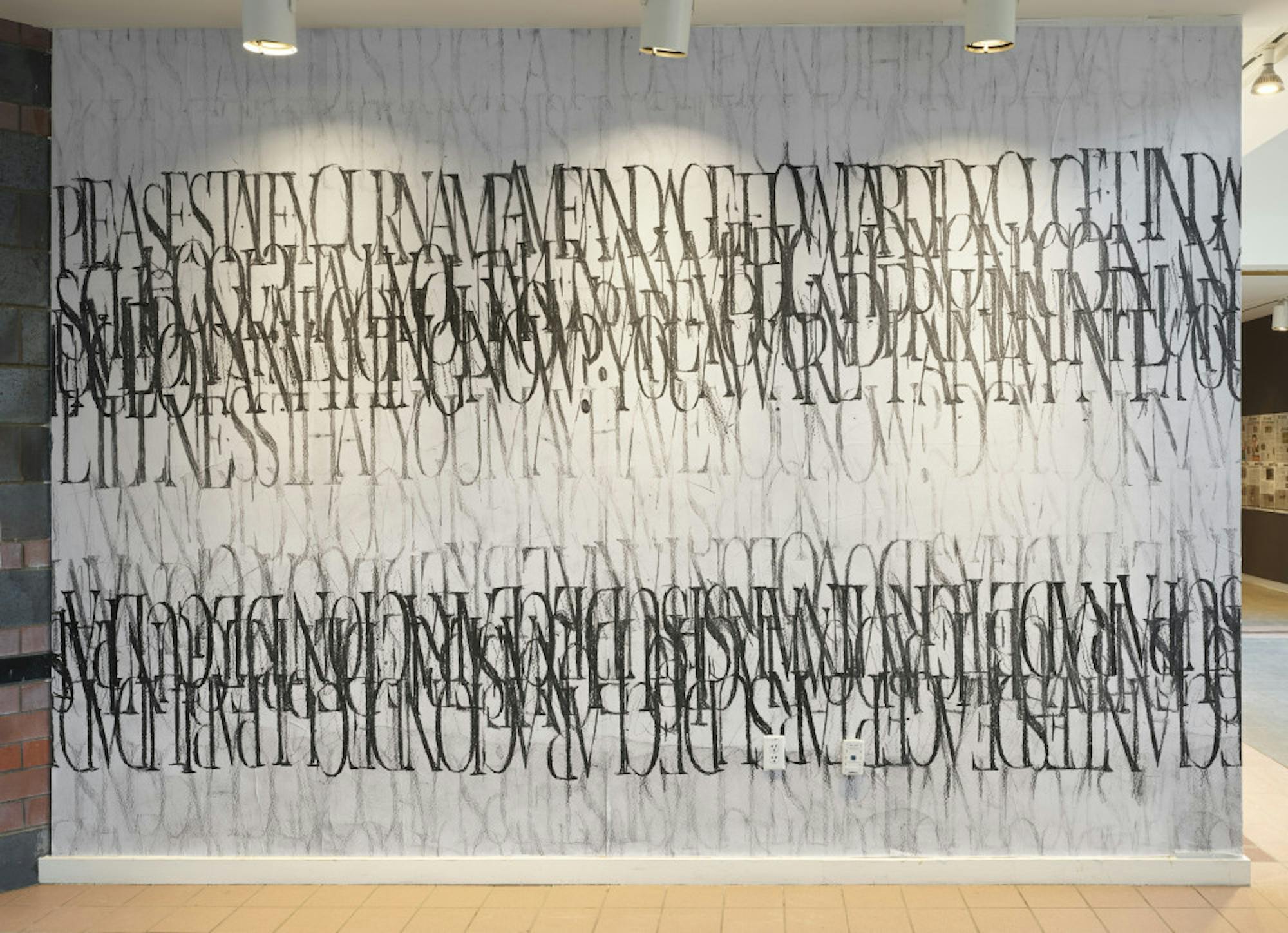Today, in an era of globalization and mass media, power manifests itself as the agency to express oneself or control others' expressions, probably more prominently than ever. The malleability of language — especially during the process of translation — becomes a possible mechanism of control and exploitation. Working within this cultural landscape, the Boston-based artist Gabriel Sosa created “Let Me Explain to You What This Means” (2018), as part of the Artist Response project at the Tufts University Art Galleries, to highlight the vulnerability of those whose words were modified or misinterpreted in court translations. The exhibition is on display in Tufts' galleries in both Medford and Boston.
Both the Medford and Boston venues of “Let Me Explain to You What This Means” establish a rather hostile institutional atmosphere. The Medford venue features the entire media wall in the Tufts Art Gallery covered by hardly intelligible text. Written with words closely interlocked and overlapping with one another, the text yields rudimentary, broken meanings that convey no more substance than merely an institutional formality and alienness. Amidst the enmeshed and, in some parts, randomly arranged letters are a few painfully hard-to-see yet recognizable words and phrases, such as “illness,” “you may,” “protection,” “criminal,” “please state your name" and “jury...” The words are written in all capital letters and in a font similar to Times New Roman, except more elongated. The formal, dispassionate style of the words communicates a sense of unapproachable legal authority.
The venue of the exhibition, the School of Museum of Fine Arts at Tufts (SMFA), features not one but three text-covered walls, which emphasize the all-encompassing and overwhelming nature of institutional power. In the middle of the walled space is a white table holding a shelf of books. The book collection features eight books related to translation and the American criminal justice system, including “After Babel” (1975), "Fundamentals of Court Interpretation” (1991), “Crook County” (2017), “The Case Against the Supreme Court” (2014), “The New Jim Crow” (2010), “Is That a Fish in Your Ear?” (2011), “The Bilingual Courtroom” (1990) and “You Have the Right to Remain Innocent” (2016). For obvious security reasons, the books are all secured underneath the table with silver wires. Be it accidentally or intentionally, this imagery of 'handcuffed' books serves as a visual metaphor for the incarcerated, some of whom are potential victims of this translational inefficiency in court on which Sosa shines the spotlight. In contrast with the clustered, tiny books, the walls appear even more high-standing and majestic. This spatial relationship between the books and its surrounding structure mirrors the asymmetry of power between the incarcerated individuals and the justice and prison system.
Sosa continues to underline the vulnerability of individuals who are subject to institutional exploitation by emphasizing their lack of both literal and figurative voice. As previously mentioned, the text printed on the wall could be seen as representing the indifferent orders of judicial institutions. However, communication is a two-way process. Consequently, a gap between the communicating parties will result in mutually insufficient or inaccurate perceptions of the other by both parties. As a result, the impersonal manner in which the institution communicates with its subjects is reciprocated by the inability of the subjects to effectively express themselves in front of the institution.
Therefore, the words on the walls of the SMFA and Medford galleries also represent the voices of the subjects of the legal system. While printed in a font resembling Times New Roman — symbolizing stylistic formality and bureaucracy — the words assume a fluid dynamic among themselves. The letters are not printed in a uniform size and opacity and are not written along straight lines. In general, the more removed a letter or a word is from the main bulk of entangled text, the more likely it is small, gray and slanted. Therefore, the overall composition on the wall depicts the words as slowly fading away from the main focus of the audience’s vision. The gradual disappearance of words mirrors the stepwise loss of meaning which the translated words of some court subjects undergo during translation. The lack of voice of those that require an interpreter in U.S. courts also manifests itself in the form of the insufficient representation of their struggles, which is, though likely inadvertently, portrayed by the in conspicuous location of Sosa’s installation. Located in the basement of the SMFA, the installation is literally beneath most people’s everyday life, just as how the issue of mistranslation in court flows like an undercurrent in most people’s lives. That being said, Sosa’s installation is not entirely a pessimistic; it is not a dead end. By offering the audience books and a reading table as part of his artistic work, he invites his audience to study the issues of race, law and language in the language not only through art, but also through logic and academic factuality.
“Let Me Explain to You What This Means” will be on view for the 2018-2019 academic year. To access the SMFA venue, Tufts students need to present their student ID at the reception desk.
'Let Me Explain to You What This Means': power lost in translation

Gabriel Sosa's 'Let Me Explain To You What This Means' (2018), a graphite drawing transferred to wheatpaste installation, is pictured.





